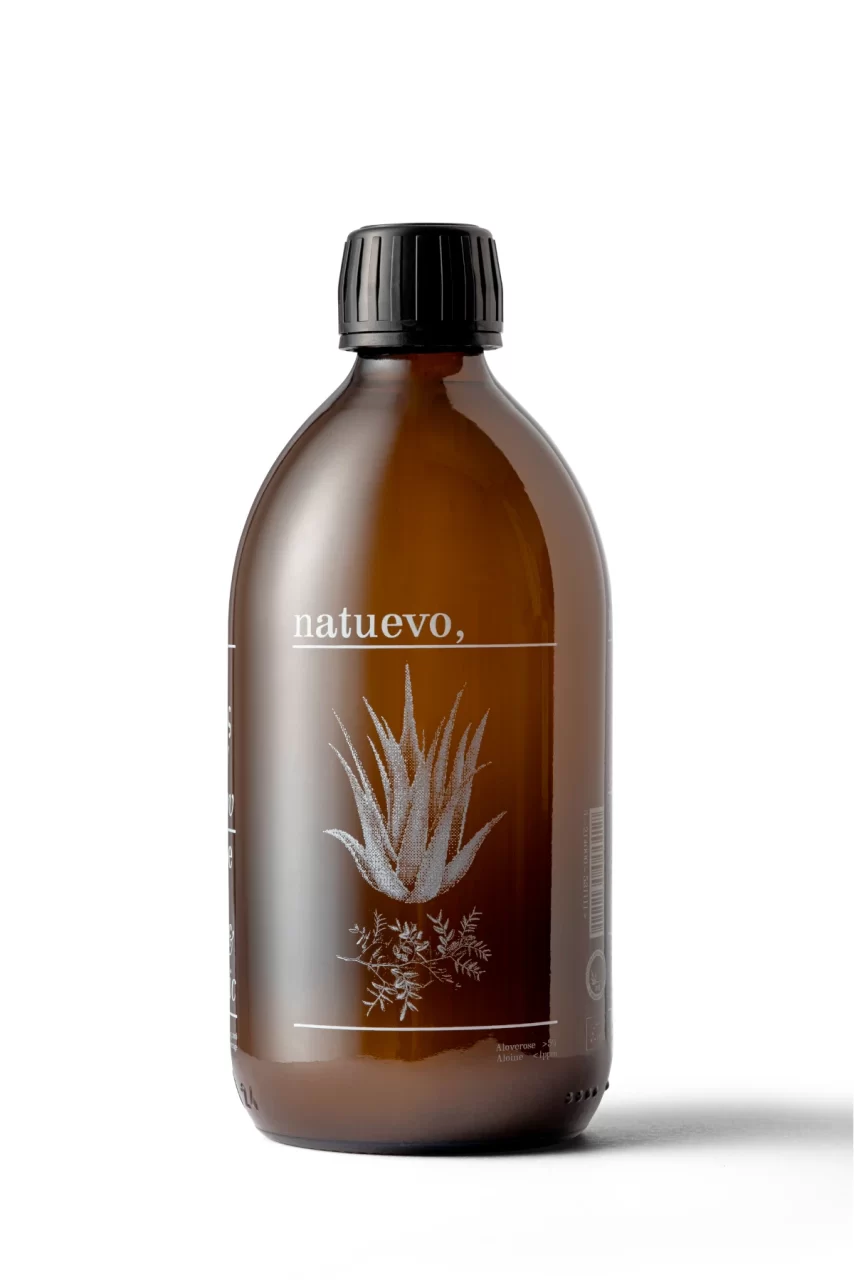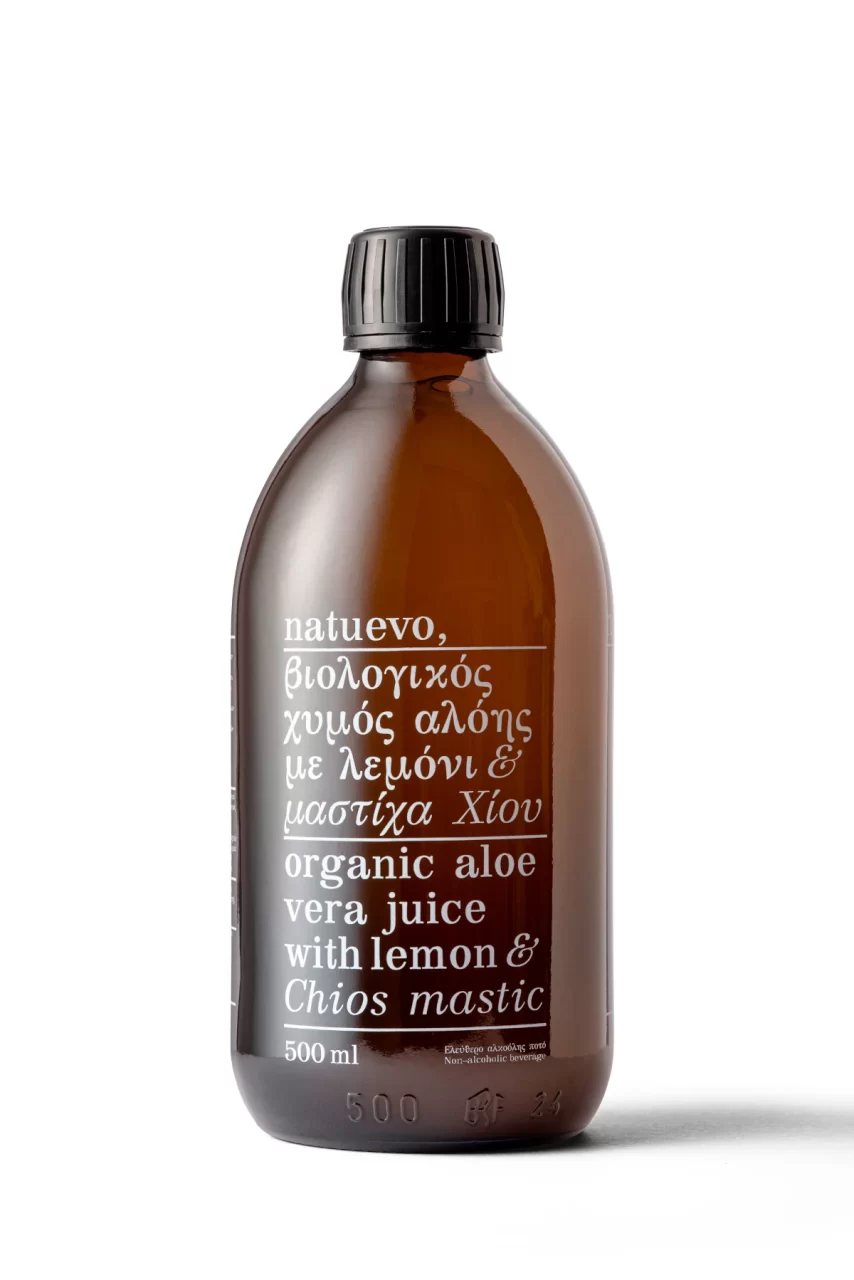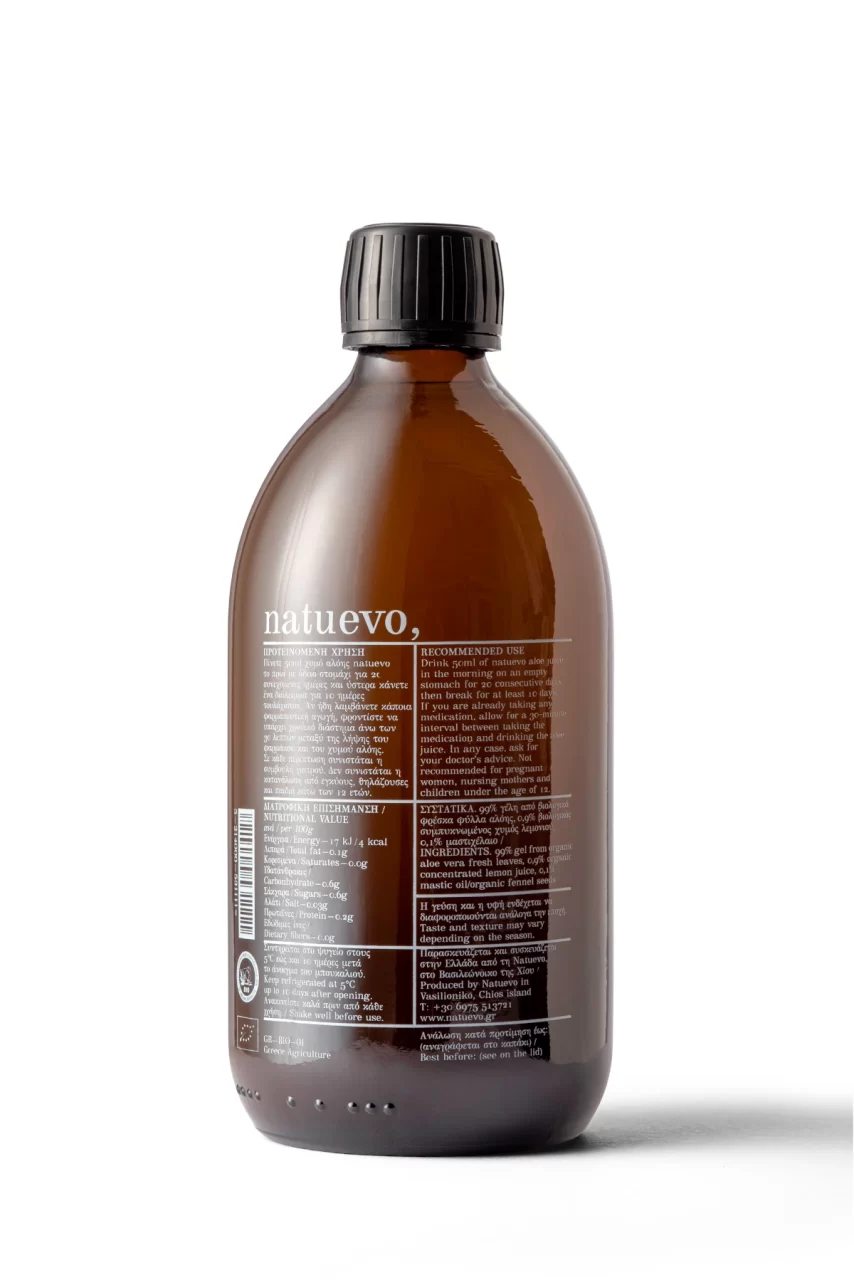General
The juice that is made from aloe vera gel contains only the inner fillet of the aloe vera leaf, which is manually separated from the outer bark that contains the yellow bitter and toxic mucus (aloe latex or aloin). The edible aloe vera gel consists of 98 % water, and the remaining 2 % contains over 200 active ingredients. The chemical composition of the solid component consists of 55 % polysaccharides, 17 % sugars, 16 % micronutrients, 7 % proteins, 4 % lipids and 1 % phenolic elements. (1)
Polysaccharides
Acemannan (or aloverose) is the main polysaccharide to be found in aloe vera, immensely popular in research on animals and on humans, as well as in laboratory tests. Acemannan is a polysaccharide with numerous pharmacological and biological applications, amongst others in stimulating the immune system, fighting cancer, dental hyperplasia and diabetes, healing ulcers of the gastrointestinal tract, and it is also known to have antioxidant and anti-inflammatory properties.
Enzymes
The enzymes found in the aloe vera plant enhance digestion, while contributing to many reactions that take place at the cellular level. Alkaline phosphatase, amylase, bradykinase, catalase, lipase, protease, creatine phosphokinase, carboxypeptidase, cellulase, oxidase, superoxide dismutase. (26, 27) Superoxide dismutase is aloe vera’s most important enzyme; research on animals has shown it to contribute to free-radical neutralization reactions. (28)
Monosaccharide
The main monosaccharide to be found in aloe vera is mannose 6 phosphate(M6P).
Probiotics
Aloe contains natural probiotics and fructans, which increase the composition of short-chain fatty acids (SCFAs) (14,15). SCFAs result from the bacterial fermentation of foods with undissolved dietary fibres. They perform important metabolic functions and are essential for good gut health. (16)
Hormones
Two plant hormones, gibberellin and auxin, activate cell reproduction and contribute to aloe vera’s healing properties.
Glycoproteins
Alprogen, a glycoprotein with anti-allergic properties.
Sterols
Lupeol, with antiseptic properties.
Phenols
The main phenol to be found in aloe vera is pyrogallol. It also contains salicylic acid, ellagic acid and ferulic acid.
Gut Health
- Constipation: Aloe vera gel has anti-inflammatory components that improve the functioning of the digestive organs, it normalizes the acidic alkaline environment by balancing the pH and fosters the growth of friendly bacteria.
- Ulcer healing: the systematic consumption of aloe has been shown to accelerate the healing of stomach ulcers (12).
- Gastroesophageal reflux disease (GERD): Comparative studies with omeprazole have shown aloe juice to palliate the reflux symptoms (13). Treatments using aloe vera gel juice can significantly reduce the cost of treatment for people living in least developed countries who have no access to classic therapies.
- Irritable Bowel Syndrome: Irritable Bowel Syndrome has no organic cause. It appears as inflammations in the intestinal lumen caused by certain foods or an imbalance in the intestinal flora. The systematic intake of aloe vera helps reduce gut inflammation and develop good bacteria-probiotics, which effectively regulate the dysbiosis that is characteristic of irritable bowel syndrome. As a result, it restores the balance in the gut brain axis. (17)
Diabetes
Numerous research has proven the systematic consumption of aloe vera juice to significantly prevent diabetes in persons predisposed to it. Clinical tests have shown it to reduce fasting blood sugar levels and blood triglycerides. (4, 5) Persons with prediabetes and type 2 diabetes in the US and Asia are being treated with Aloe Vera juice, and the outcomes are impressive, resulting even in the reduction or elimination of medical treatments, provided there is close supervision by the treating physician. The hypoglycaemic action of aloe through its ability to enhance cell sensitivity to insulin makes it promising for the regulation of prediabetic and diabetic patients. In fact, one clinical study showed aloe vera to be superior to the anti-diabetic drug glyperidine and demonstrated an increase in the ability of pancreatic islets to secrete insulin, substantially favouring the regulation of diabetes. (6)
Weight Loss
The probiotics found in aloe vera increase the composition of SCFAs (propionic acid, butyric acid, acetic acid), which are absorbed through circulation and influence the liver, the adipose tissue, the muscles and the brain. They regulate the metabolism by increasing the secretion of leptin by the adipose tissue, a hormone that reduces appetite, and at the same time act directly on the brain, which signals satiation and thus leads to weight loss (16). In addition, SCFAs affect the liver and muscles, increasing the sensitivity of cells to insulin; in practice, this means that the cells incept more glucose from the blood and, therefore, blood glucose decreases. This can treat glucose intolerance in cases of prediabetes and help to better regulate the metabolism of carbohydrates in diabetic people. (20)
Immune System
The immune system-enhancing properties of aloe vera are due to the polysaccharides found in the plant, particularly acemannan. It significantly tones the immune system through the activation of interleukin 1 IL-1, cytokines, the TNF factor and through the maturation of dendritic cells and macrophages, cells responsible for cellular immunity. (2) Through macrophage activation, nitric acid is secreted which has a potent immunomodulatory effect, enhancing immunity in animal and laboratory studies. (3)
LDL and HDP Cholesterol
Aloe vera gel helps reduce LDL cholesterol and improve HDL cholesterol, while at the same time decreasing triglycerides and thus the overall risk of metabolic syndrome in diabetic and prediabetic individuals. Research conducted on humans has shown significant improvement in the lipid profile with the administration of 500 mg of aloe twice a day. (4)
Cancer
Laboratory research has demonstrated the anti-tumour properties of aloe vera in many types of cancer, including colorectal cancer, hepatoma, leukaemia, skin cancer, lung adenocarcinoma, prostate and pancreatic cancer. (7) Furthermore, studies conducted on mice have shown acemannan to be highly effective in reducing complications in radiotherapy, with a significant reduction in mice mortality when radiotherapy was combined with the administration of acemannan. (8)
Reduction of oxidative stress
Aloe Vera contains vitamins A, C, E which have powerful antioxidant properties. The antioxidant action of aloe is enhanced by its ability to reduce the free radicals resulting from the biological reactions of the short-chain fatty acids (SCFA) produced during the fermentation of aloe fibres by its probiotics in the intestinal lumen. Furthermore, Aloe Vera has a natural antioxidant action due to the enzyme superoxide dismutase, which has been shown to reduce oxidative stress in the liver in animal studies. (28)
Anti-inflammatory action
Aloe Vera gel boasts significant antimicrobial, antiviral and antifungal action. It has shown promising results in the treatment of strains resistant to antimicrobial drugs, as it appears to act as a potent therapeutic agent in pseudomonas strains. (19) It is also highly effective in the treatment of oral herpes simplex. (29)
Skin
Α. Healing action: The healing properties of Aloe Vera in wounds on the skin and oral mucosa have been proven by many studies showing an increase in type I and III collagen. Furthermore, acemannan has recently been shown to have an effect on gingival fibroblasts, thus helping in stomatitis and in inflammations of the oral cavity. The antibacterial properties of fresh aloe vera juice contribute significantly to the reduction of inflammations in the gastrointestinal tract.
Β. Hydration and Anti-Aging: The polysaccharides in aloe activate fibroblasts, which in turn produce collagen and elastin in the skin, keeping it supple and wrinkle-free. (9)
Dentistry
Acemannan promotes bone formation and increases the speed of new bone growth, bone density, and recovery after dental procedures. (10) Research has demonstrated the effectiveness of aloe polysaccharides in the formation of dentin in children aged 7 to 11.(11)
References
- Ahlawat KS, Khatkar BS. Processing, food applications and safety of aloe vera products: a review. J Food Sci Technol. 2011;48(5):525-533. doi:10.1007/s13197-011-0229-z
- Sanders B, Ray AM, Goldberg S, et al. Anti-cancer effects of aloe-emodin: a systematic review. J Clin Transl Res. 2017;3(3):283-296. Published 2017 Sep 7.
- Liu C, Cui Y, Pi F, Cheng Y, Guo Y, Qian H. Extraction, Purification, Structural Characteristics, Biological Activities and Pharmacological Applications of Acemannan, a Polysaccharide from Aloe vera: A Review. Molecules. 2019;24(8):1554. Published 2019 Apr 19. doi:10.3390/molecules24081554
- Alinejad-Mofrad S, Foadoddini M, Saadatjoo SA, Shayesteh M. Improvement of glucose and lipid profile status with Aloe vera in pre-diabetic subjects: a randomized controlled-trial. J Diabetes Metab Disord. 2015;14:22. Published 2015 Apr 9. doi:10.1186/s40200-015-0137-2
- Suksomboon N, Poolsup N, Punthanitisarn S. Effect of Aloe vera on glycaemic control in prediabetes and type 2 diabetes: a systematic review and meta-analysis. J Clin Pharm Ther. 2016 Apr;41(2):180-8. doi: 10.1111/jcpt.12382. Epub 2016 Mar 23. PMID: 27009750.
- Amira Mourad Hussein Abo-Youssef, Basim Anwar Shehata Messiha,Beneficial effects of Aloe vera in treatment of diabetes: Comparative in vivo and in vitro studies,Bulletin of Faculty of Pharmacy, Cairo University,Volume 51, Issue 1,2013,Pages 7-11,ISSN 1110-0931,https://doi.org/10.1016/j.bfopcu.2012.03.002.
- Hsu SC, Chung JG. Anticancer potential of emodin. Biomedicine (Taipei). 2012;2(3):108-116. doi:10.1016/j.biomed.2012.03.003
- Kumar S., Tiku A.B. Immunomodulatory potential of acemannan (polysaccharide from Aloe vera) against radiation induced mortality in Swiss albino mice. Food Agric. Immunol. 2016;27:72–86. doi: 10.1080/09540105.2015.1079594. [CrossRef] [Google Scholar] [Ref list]
- Surjushe A, Vasani R, Saple DG. Aloe vera: a short review. Indian J Dermatol. 2008;53(4):163-166. doi:10.4103/0019-5154.44785
- Boonyagul S., Banlunara W., Sangvanich P., Thunyakitpisal P. Effect of acemannan, an extracted polysaccharide from Aloe vera, on BMSCs proliferation, differentiation, extracellular matrix synthesis, mineralization, and bone formation in a tooth extraction model. 2014;102:310–317. doi: 10.1007/s10266-012-0101-2.
- Songsiripradubboon S., Banlunara W., Sangvanich P., Trairatvorakul C., Thunyakitpisal P. Clinical, radiographic, and histologic analysis of the effects of acemannan used in direct pulp capping of human primary teeth: Short-term outcomes. 2016;104:329–337. doi: 10.1007/s10266-015-0215-4.
- Eamlamnam K, Patumraj S, Visedopas N, Thong-Ngam D. Effects of Aloe vera and sucralfate on gastric microcirculatory changes, cytokine levels and gastric ulcer healing in rats. World J Gastroenterol. 2006 Apr 7;12(13):2034-9. doi: 10.3748/wjg.v12.i13.2034. PMID: 16610053; PMCID: PMC4087681.
- Panahi Y, Khedmat H, Valizadegan G, Mohtashami R, Sahebkar A. Efficacy and safety of Aloe vera syrup for the treatment of gastroesophageal reflux disease: a pilot randomized positive-controlled trial. J Tradit Chin Med. 2015 Dec;35(6):632-6. doi: 10.1016/s0254-6272(15)30151-5. PMID: 26742306.
- Quezada MP, Salinas C, Gotteland M, Cardemil L. Acemannan and Fructans from Aloe vera (Aloe barbadensis Miller) Plants as Novel Prebiotics. J Agric Food Chem. 2017 Nov 22;65(46):10029-10039. doi: 10.1021/acs.jafc.7b04100. Epub 2017 Nov 8. PMID: 29072072.
- Teng-Gen Hu, Peng Wen, Hui-Zhan Fu, Guang-Yue Lin, Sen-Tai Liao and Yu-Xiao Zou
Protective effect of mulberry (Morus atropurpurea) fruit against diphenoxylate-induced constipation in mice through the modulation of gut microbiota. Food Funct., 2019, 10, 1513
DOI: 10.1039/C9FO00132H
- Canfora, E., Jocken, J. & Blaak, E. Short-chain fatty acids in control of body weight and insulin sensitivity. Nat Rev Endocrinol11, 577–591 (2015). https://doi.org/10.1038/nrendo.2015.128
- Hong SW, Chun J, Park S, Lee HJ, Im JP, Kim JS. Aloe veraIs Effective and Safe in Short-term Treatment of Irritable Bowel Syndrome: A Systematic Review and Meta-analysis. J Neurogastroenterol Motil. 2018;24(4):528-535. doi:10.5056/jnm18077
- Sánchez M, González-Burgos E, Iglesias I, Gómez-Serranillos MP. Pharmacological Update Properties of Aloe Veraand its Major Active Constituents. Molecules. 2020;25(6):1324. Published 2020 Mar 13. doi:10.3390/molecules25061324
- Goudarzi M, Fazeli M, Azad M, Seyedjavadi SS, Mousavi R. Aloe vera Gel: Effective Therapeutic Agent against Multidrug-Resistant Pseudomonas aeruginosa Isolates Recovered from Burn Wound Infections. Chemother Res Pract. 2015;2015:639806. doi: 10.1155/2015/639806. Epub 2015 Jul 22. PMID: 26266047; PMCID: PMC4525459.
- Layden Brian, Anthony Anqueira, Brodsky Michael, Durai vivek, Lowe Jr William. Short Chain Fatty Acids and their receptors: new metabolic targets. November 2012. DOI: https://doi.org/10.1016/j.trsl.2012.10.007
- Huseini HF, Kianbakht S, Hajiaghaee R, Dabaghian FH. Anti-hyperglycemic and anti-hypercholesterolemic effects of Aloe vera leaf gel in hyperlipidemic type 2 diabetic patients: a randomized double-blind placebo-controlled clinical trial. Planta Med. 2012;78:311-316. [PubMed] [DOI] [Cited in This Article: 2] [Cited by in CrossRef: 68]
- Yimam M, Brownell L, Jia Q. Aloesin as a medical food ingredient for systemic oxidative stress of diabetes. World J Diabetes2015; 6(9): 1097-1107 [PMID: 26265996 DOI: 4239/wjd.v6.i9.1097]
- Fenig, Eyal & Nordenberg, Ja & Beery, Einat & Sulkes, Jaqueline & Wasserman, Lina. (2004). Combined effect of aloe-emodin and chemotherapeutic agents on the proliferation of an adherent variant cell line of Merkel cell carcinoma. Oncology reports. 11. 213-7. 10.3892/or.11.1.213.
- Hekmatpou D, Mehrabi F, Rahzani K, Aminiyan A. The Effect of Aloe Vera Clinical Trials on Prevention and Healing of Skin Wound: A Systematic Review. Iran J Med Sci. 2019 Jan;44(1):1-9. PMID: 30666070; PMCID: PMC6330525.
- Barak-Shinar D, Del Río R, Green LJ. Treatment of Seborrheic Dermatitis Using a Novel Herbal-based Cream. J Clin Aesthet Dermatol. 2017;10(4):17-23.
- Hęś, M., Dziedzic, K., Górecka, D. et al.Aloe vera (L.) Webb.: Natural Sources of Antioxidants – A Review. Plant Foods Hum Nutr 74, 255–265 (2019). https://doi.org/10.1007/s11130-019-00747-5
- Gao Y, Kuok KI, Jin Y, Wang R (2018) Biomedical applications of Aloe vera. Crit Rev Food Sci Nutr 13:1–13. https://doi.org/10.1080/10408398.2018.1496320
- Ariani, Nia & Gofur, Abdul & Listyorini, Dwi & Susanto, Hendra & Handaya, Adeodatus yuda. (2015). EFFECT OF Aloe vera GEL ON SUPEROXIDE DISMUTASE (SOD) LEVEL IN STREPTOZOTOCIN (STZ)-INDUCED DIABETIC WISTAR Rattus novergicus LIVER. KnE Life Sciences. 2. 51. 10.18502/kls.v2i1.116.
- Rezazadeh F, Moshaverinia M, Motamedifar M, Alyaseri M. Assessment of Anti HSV-1 Activity of Aloe Vera Gel Extract: an In Vitro Study. J Dent (Shiraz). 2016;17(1):49-54.





